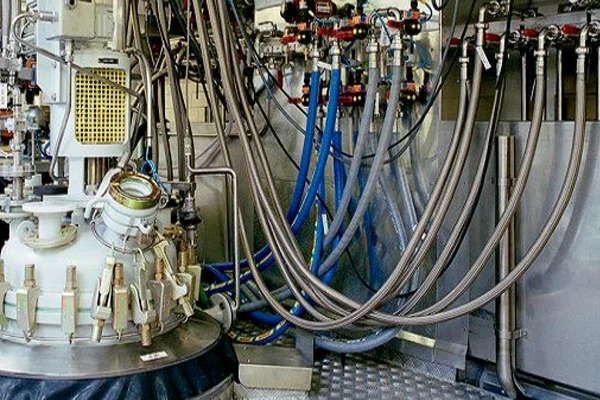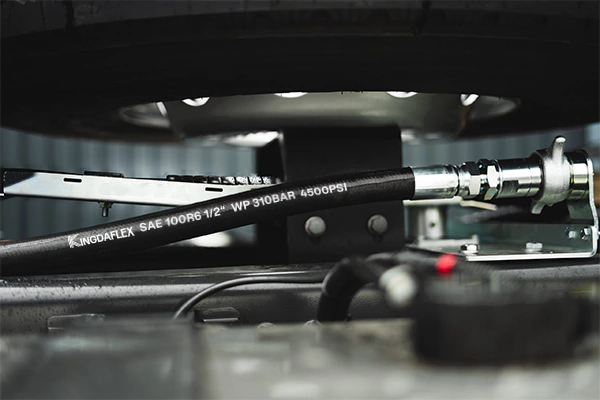Here are many types of industrial hoses in the market, and today we are talking about the oxygen hose. Let’s dive into this blog.
What Is An Oxygen Hose?
![What Is Oxygen Hose? The Complete Guide 2025 [Updated] 1 what is oxygen hose](https://kingdaflex.com/wp-content/uploads/2023/02/what-is-oxygen-hose.webp)
The oxygen hose is a top-quality single-line welding hose that is exclusively designed for oxygen service. It features a tube and cover that are both flame and oil resistant, making it suitable for use in various applications.
This hose is available in long, uninterrupted lengths, offering maximum flexibility and ease of handling. It is ideal for situations where only an oxygen hose is required or when the fuel gas and oxygen sources are separated and using a twin-line hose is not feasible.
An oxygen hose is a type of hose that is used to transfer oxygen from a source to an appliance or device. It is designed specifically for oxygen use and is made of materials that are resistant to the high pressure, high temperature, and corrosive properties of oxygen.
Oxygen hoses are commonly used in medical, industrial, and commercial applications where oxygen is used for breathing, welding, and other processes. They are available in a variety of types, such as reinforced rubber hoses, stainless steel braided hoses, and polyamide hoses, each designed for specific applications and environments.
What Color Is An Oxygen Hose When Welding?
![What Is Oxygen Hose? The Complete Guide 2025 [Updated] 3 oxygen hose color](https://kingdaflex.com/wp-content/uploads/2023/02/oxygen-hose-color.webp)
The standard color code for oxygen hoses in welding is green. This color coding helps to prevent accidental mixing of gases, which is crucial for safety.
Here’s a breakdown of the standard color codes for welding hoses:
- Oxygen Hose: Green
- Acetylene Hose: Red
- Fuel Gas Hose (other than acetylene): Orange
- Inert Gas Hose (argon, helium, etc.): Black
| Gas | Oxygen Hose Color |
|---|---|
| Oxygen | Green |
| Acetylene | Red |
| Fuel Gas (other than acetylene) | Orange |
| Inert Gas (argon, helium, etc.) | Black |
Why Oxygen Hose Color Coding is Important
Color coding for welding hoses is a crucial safety measure that helps prevent accidents and ensure the correct gas is delivered to the welding torch. Here’s why it’s so important:
Preventing Accidental Mixing:
- Fire Hazard: Mixing oxygen and fuel gases can create a highly flammable mixture, leading to explosions and fires.
- Equipment Damage: Incorrect gas mixtures can damage the welding equipment and reduce its lifespan.
Ensuring Proper Welding:
- Optimal Flame: The correct gas mixture is essential for achieving the desired flame temperature and quality of the weld.
- Efficient Welding: Using the correct gases ensures that the welding process is efficient and produces high-quality welds.
Quick Identification:
- Easy Recognition: Color coding allows welders to quickly identify the correct hose for each gas, reducing the risk of errors.
- Faster Setup: By easily recognizing the hoses, welders can set up their equipment more efficiently.
By adhering to the standard color codes and using the correct hoses, welders can significantly reduce the risk of accidents and ensure a safe and efficient welding process.
Additional Safety Tips:
- Always inspect hoses for damage before use.
- Replace damaged hoses immediately.
- Never use a hose that is not designed for the specific gas.
- Always turn off the gas supply when not in use.
- Be aware of the location of the shut-off valves for both the oxygen and fuel gas cylinders.
By following these guidelines, you can help ensure a safe and efficient welding experience.
What Is Oxygen Hose Made of?
![What Is Oxygen Hose? The Complete Guide 2025 [Updated] 4 blue oxygen hose](https://kingdaflex.com/wp-content/uploads/2023/02/blue-oxygen-hose.webp)
Oxygen hoses can be made of a variety of materials, depending on their intended use and the specific requirements of the application. Some of the most common materials used in oxygen hoses include:
- Rubber: Rubber is a common material for oxygen hoses because of its flexibility, durability, and resistance to heat, weathering, and ozone. Rubber hoses can withstand high pressure and high temperature and are also resistant to abrasion.
- Stainless Steel: Stainless steel is a high-quality material that is resistant to corrosion and rust. It is also strong and durable, making it ideal for use in oxygen hoses that require high pressure and high temperature resistance. Stainless steel braided hoses are made by covering a flexible inner hose with a layer of stainless steel braid.
- Polyamide: Polyamide is a lightweight and flexible material that is ideal for portable and mobile applications. It is resistant to heat, weathering, and ozone, and can withstand high pressure and high temperature. Polyamide hoses are made of a polyamide inner hose covered with a reinforcement layer and an outer protective cover.
How Do You Use an Oxygen Hose
How to Use an Oxygen Hose for Welding?
1. Connect the Hose:
- Ensure the oxygen hose is securely connected to the oxygen regulator.
- The other end of the hose should be connected to the oxygen inlet on your welding torch.
- Always double-check the connections to prevent leaks.
2. Open the Cylinder Valve:
- Slowly open the valve on the oxygen cylinder.
- Be cautious to avoid sudden pressure surges.
3. Adjust the Regulator:
- Use the regulator to set the desired oxygen pressure.
- The specific pressure needed will depend on the type of welding you’re doing. Consult your welding manual for precise settings.
4. Ignite the Torch:
- Open the acetylene valve slightly and ignite the gas with a spark lighter.
- Gradually increase the oxygen flow to adjust the flame.
5. Welding Process:
- Use the welding torch to heat the metal and melt the filler rod.
- Manipulate the torch and filler rod to create the desired weld.
- Adjust the oxygen and acetylene flow as needed to maintain the correct flame.
6. Safety Precautions:
- Never oil or grease oxygen equipment. Oil and grease can ignite spontaneously in the presence of oxygen.
- Inspect hoses for damage before each use. Replace damaged hoses immediately.
- Wear appropriate safety gear: This includes safety glasses, gloves, and a welding helmet.
- Be aware of your surroundings. Keep flammable materials away from the welding area.
- Turn off the gas supply and release pressure from the hoses when you’re finished welding.
Remember, always follow the specific instructions provided by your welding equipment manufacturer. If you’re unsure about any step, consult a qualified welding professional.
What Are the Differences Between Oxygen Hoses and Fuel Hoses
![What Is Oxygen Hose? The Complete Guide 2025 [Updated] 5 oxygen hose vs fuel hose](https://kingdaflex.com/wp-content/uploads/2023/02/oxygen-hose-vs-fuel-hose-1024x576.webp)
Oxygen and fuel hoses are specifically designed for different purposes and have distinct characteristics:
Oxygen Hoses:
- Material: Made from materials that are resistant to oxidation and high pressures.
- Color Coding: Typically blue to easily distinguish it from fuel hoses.
- Pressure Rating: Higher pressure rating to handle the pressure of oxygen gas.
- Compatibility: Compatible with oxygen gas only.
- Safety: Designed to prevent leaks and explosions, especially when handling pure oxygen.
Fuel Hoses:
- Material: Made from materials that are resistant to the specific fuel gas being used (e.g., acetylene, propane).
- Color Coding: Varies depending on the fuel gas (e.g., red for acetylene).
- Pressure Rating: Lower pressure rating than oxygen hoses, as fuel gases are typically at lower pressures.
- Compatibility: Compatible with specific fuel gases only.
Key Differences:
| Feature | Oxygen Hose | Fuel Hose |
|---|---|---|
| Material | Oxidation-resistant | Fuel-gas-resistant |
| Color Coding | Blue | Varies (e.g., red for acetylene) |
| Pressure Rating | Higher | Lower |
| Compatibility | Oxygen gas only | Specific fuel gas |
| Safety Considerations | Prevent leaks and explosions | Prevent leaks and fires |
Why the Differences Matter:
- Safety: Using the wrong hose can lead to serious accidents, including fires and explosions.
- Performance: Incorrect hoses can affect the quality of the welding process.
- Durability: Each hose type is designed for specific conditions and pressures.
Always use the correct hose for the specific gas to ensure safety and optimal performance.
Conclusion
In addition to these materials, oxygen hoses may also include other components such as fittings, clamps, and reinforcement layers to improve their strength, flexibility, and durability.
It is important to choose an oxygen hose that is made of materials that are suitable for the specific requirements of the application to ensure safe and efficient oxygen transfer.
Need a reliable oxygen hose?
Look no further than Kingdaflex! Their high-quality oxygen hoses are designed to meet the demands of various industries.
Ready to purchase? Visit our website or contact their sales team today to get your hands on the best oxygen hose for your needs.

![What Is Oxygen Hose? The Complete Guide 2025 [Updated] 2 Oxygen Hose](https://kingdaflex.com/wp-content/uploads/2021/06/Oxygen-Hose.jpg)



